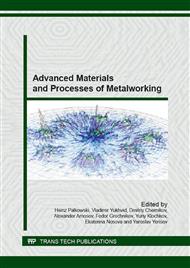p.193
p.198
p.204
p.211
p.218
p.222
p.227
p.234
p.242
Development and Enhancement of Thin-Walled Tube Separation Methods
Abstract:
The correct choice of a metal separation method, in particular for thin-walled tubes, is vital for technical and economical performance indices in aircraft building. The most important selection criteria are separation quality, the amount of waste, possibility to consolidate operations and equipment efficiency. These factors require ongoing development & enhancement of tube separation methods. Waste-free technological processes like torsion tube sectioning are preferred. As the result of the extended research of tube separation process using torsion with active counterpressure, particularly the effect of structural parameters on cut quality, optimum tolerance for clearance fit between dies was defined. Compliance with recommended practices during equipment manufacturing will let cut quality reach the value peculiar to the quality value of sectioning method of separation using metal-cutting equipment. Herewith manufacturing becomes waste-free and quarantines calibration of sections adjacent to the cut.
Info:
Periodical:
Pages:
218-221
Citation:
Online since:
February 2016
Authors:
Keywords:
Price:
Сopyright:
© 2016 Trans Tech Publications Ltd. All Rights Reserved
Share:
Citation:


